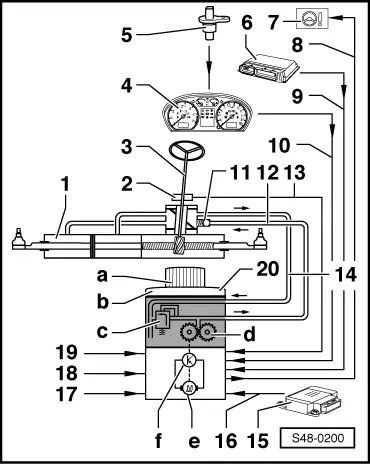| The EPHS (Electrically Powered Hydraulic Steering) is a power-assisted steering system which uses its own electric motor to drive the pump. |
| 2 - | Sensor for power steering -G250- |
| 4 - | Control unit in dash panel insert -J285- |
| 5 - | Sender for speedometer -G22- |
| 7 - | Servotronic warning light -K92- in dash panel insert |
| 8 - | Signal for servotronic warning light -K92- via data BUS |
| 9 - | Signal for engine speed via data BUS |
| 10 - | Signal for driving speed via data BUS |
| 11 - | Hollow screw with non-return valve |
| 13 - | Signal for steering angle speed |
| 15 - | Airbag control unit -J234- |
| 16 - | Crash signal over the databus |
| 20 - | Engine pump aggregate - consisting of: |
| b - | Reservoir for hydraulic oil |
| c - | Pressure limiting valve |
| f - | Power-assisted steering control unit -J500- |
| The steering hydraulics pump -V119- includes the gear pump -d- and the electric motor -e-. |
| The gear pump is integrated into the engine pump aggregate. |
| This gear pump -d- is driven by an electric motor -e- integrated into the engine pump aggregate. |
| Signals for steering angle speed -13-, for vehicle speed -10- and engine speed -9- are sent to the control unit -f-. This control unit controls the speed of the electric motor -e- on the gear pump and thus also the supplied quantity or volume of hydraulic oil. |
| The electrohydraulic power-assisted steering has a re-engaging protection after faults, failure or crash. |
| After a crash or after the display of the crash signal on the vehicle diagnosis, measurement and information system -VAS- the vehicle memory must be erased to de-activate the re-engaging protection. |
| The re-engaging protection can be neutralised by switching off the ignition and switching it on again. If necessary wait 15 minutes to allow the engine pump aggregate to cool down after overheating. If after this waiting period the re-engaging protection cannot be neutralised by switching the engine on again, the fault must be found in the vehicle electric system or e.g. in the engine pump aggregate. In these instances perform the self-diagnosis and if necessary replace the engine pump aggregate. |
|
|

|

